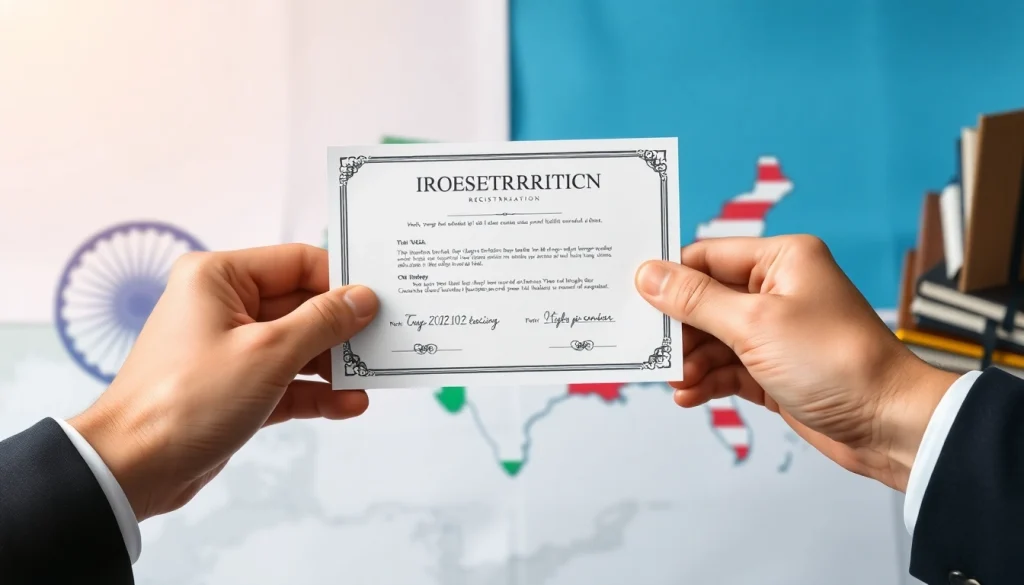Understanding Trademark Registration
What is a Trademark?
A trademark is a distinctive sign, symbol, or expression that identifies and distinguishes the source of goods or services of one entity from those of others. Trademarks can take various forms, including words, logos, colors, sounds, and shapes. The essence of a trademark is its ability to convey the quality and reputation of a brand. For businesses, a trademark adds significant value: it serves as a source identifier, helps build brand loyalty, and protects consumers from confusion. The legal protection provided through trademark registration secures the exclusive rights to use the mark in a specific category of goods or services.
Importance of Trademark Registration
Trademark registration is crucial for establishing legal ownership and protection of a brand. The benefits include:
- Legal Protection: A registered trademark grants the owner exclusive rights, protecting the brand from unauthorized use and imitation.
- Brand Recognition: Registration solidifies a brand’s identity and enhances its market presence, thereby increasing consumer trust.
- Infringement Management: It provides legal recourse to the trademark owner in case of infringement or unauthorized use of their trademark.
- Asset Value: Trademarks can become valuable business assets, contributing to the overall value of a company, especially during mergers, acquisitions, or sales.
How Trademarks Function in India and the US
Trademark laws in India and the United States share foundational principles but differ significantly in their application and processes. In both jurisdictions, a trademark is territorial; it provides protection solely within the borders of the nation where it is registered. However, the registration processes, renewal obligations, and enforcement mechanisms can vary, making it essential for businesses operating internationally to understand both frameworks. For deeper exploration, check out trademark registration in India and US.
Trademark Registration Process in India
Steps to Register a Trademark in India
The trademark registration process in India involves several key steps:
- Pre-Application Search: Before filing, it’s advisable to conduct a thorough search to ensure that the trademark is unique and not similar to existing registered trademarks.
- Filing the Application: Applicants must fill out Form TM-A, providing details such as the trademark, class of goods or services, and applicant information. The application must be submitted to the Trademark Registry.
- Examination Report: The Trademark Office will conduct an examination of the application. This stage includes a review of the application for compliance with legal requirements and potential conflicts with existing trademarks.
- Publication in the Trademark Journal: If the application is accepted, it is published in the Trademark Journal. This allows third parties an opportunity to oppose the registration.
- Opposition Period: There is a period of four months from the date of publication during which any person can oppose the registration of the trademark.
- Registration: If no opposition is filed (or if the opposition is resolved in favor of the applicant), the trademark is registered, and a registration certificate is issued.
Documentation Required for Indian Registration
The following documents are typically required for trademark registration in India:
- Application form (Form TM-A)
- Identity proof of the applicant (Aadhar card, passport, etc.)
- Business registration documents (if applicable)
- Trademark representation (logo or design)
- List of goods/services that the trademark will cover
Common Challenges in Indian Trademark Registration
While the process is well-defined, applicants may encounter several challenges, including:
- Acceptance Delays: The processing time may vary significantly, leading to delays in acceptance and registration.
- Opposition: Previous registrations or existing trademarks can lead to opposition, requiring legal resolutions.
- Documentation Errors: Incomplete or inaccurate documentation can cause rejection or delays in processing.
- Misclassification: Incorrectly classifying goods or services can lead to complications in securing trademark rights.
Trademark Registration Process in the US
Steps to Register a Trademark in the US
The trademark registration process in the United States is overseen by the United States Patent and Trademark Office (USPTO) and includes the following steps:
- Conduct a Trademark Search: Similar to India, conducting a comprehensive trademark search is essential to identify any existing conflicting marks.
- Filing the Application: The application is filed with the USPTO through TEAS (Trademark Electronic Application System). Applicants must specify their trademark, goods/services categories, and provide a specimen of the trademark use.
- Examiner Review: After submission, a USPTO examining attorney reviews the application, focusing on compliance with the Trademark Act and potential conflicts with existing trademarks.
- Publication for Opposition: If approved, the trademark is published in the “Official Gazette.” This publication opens a 30-day window for any third parties to oppose the registration.
- Registration: If there are no oppositions, or if any opposition is resolved, the trademark will be registered, and the owner receives a registration certificate.
Documentation Required for US Registration
Key documentation required for registering a trademark in the US includes:
- Completed trademark application (TEAS)
- Specimens showing the trademark in use
- Owner identification details
- Description of goods/services associated with the trademark
Common Challenges in US Trademark Registration
Numerous challenges may arise during the trademark registration process in the US, such as:
- Complexity of the Law: Trademark law in the US can be complex and difficult to navigate for non-legal professionals.
- Opposition Risks: English-speaking applicants may face opposition that they weren’t initially aware of due to the extensive trademark database.
- Inadequate Documentation: Providing insufficient or improper documentation can lead to application denial.
- Failure to Respond: Not responding promptly to office actions (requests for more information from the USPTO) may jeopardize the application.
Key Differences Between Indian and US Trademark Laws
Filing Procedures: India vs. US
The filing procedures in India and the US have marked differences. In India, applicants must follow the Trademark Registry’s specific requirements under the Trade Marks Act of 1999, whereas in the US, filings are handled through the USPTO based on the Trademark Act of 1946. Both jurisdictions allow for electronic filing; however, the US system is seen as more modernized and efficient, with the TEAS system streamlining many aspects of the trademark application process.
Renewal and Maintenance Requirements
Renewal processes also differ significantly between the two countries. In India, trademark registration is valid for a period of ten years and can be renewed indefinitely for further ten-year periods. The owner must file a renewal application before the expiration date. In contrast, in the US, trademark maintenance requires periodic filings. After registration, the trademark owner must submit a Declaration of Use between the fifth and sixth year and renew the trademark every ten years. Failure to meet these requirements can lead to the cancellation of a trademark.
Enforcement and Rights Retention
Enforcement of trademark rights is fundamentally similar in both countries; trademark owners have the right to sue for infringement or dilution. However, the approaches to enforcement may differ. In the US, federal courts generally handle trademark disputes, and substantial damages can be sought for infringement. India, while also providing avenues for enforcement, may pose challenges in court effectiveness and the speed at which disputes are resolved.
Best Practices for International Trademark Protection
Using the Madrid Protocol for Global Protection
The Madrid Protocol provides a convenient mechanism for businesses looking to secure trademark protection in multiple countries. By filing one application with a single fee, trademark owners can extend protection to over 120 member countries. This strategy minimizes administrative burdens and offers flexibility in managing global trademarks. Businesses should explore the benefits and processes related to this international treaty before pursuing country-specific registrations.
Strategies for Foreign Companies
When foreign companies aim to register trademarks in India and the US, they must consider the following strategies:
- Local Representation: Engaging a local attorney can significantly streamline the application process and ensure compliance with local regulations.
- Prior Local Registrations: Understanding local laws may require prior registrations in the home country, ensuring a smoother transition into foreign markets.
- Monitor Global Markets: Regularly monitoring markets for potential infringement and market changes can help prevent disputes and loss of trademark rights.
Future Trends in Trademark Registration
The landscape of trademark registration is constantly evolving, influenced by technology, globalization, and consumer behavior. Key trends to look out for include:
- Increased Digital Registration: The digitization of trademark offices and processes will likely continue to simplify registrations.
- Automation and AI: Advancements in technology may enhance the trademark search and application processes, reducing instances of human error.
- Greater Emphasis on Global Protection: As businesses expand into new markets, understanding international trademark agreements like the Madrid Protocol will become increasingly vital.





